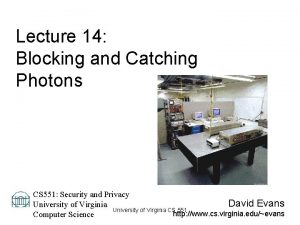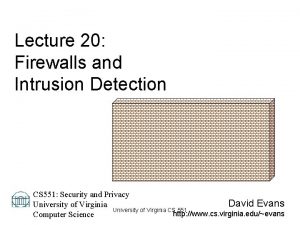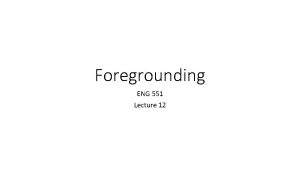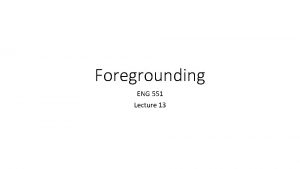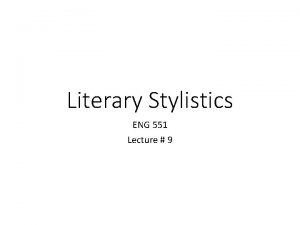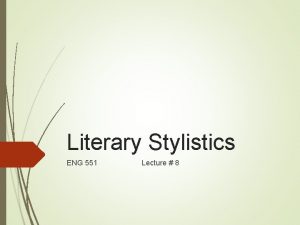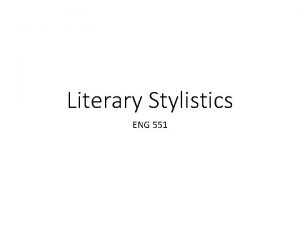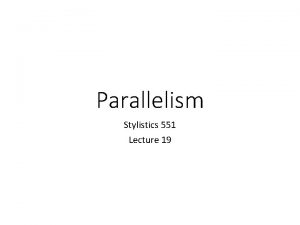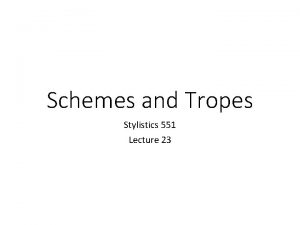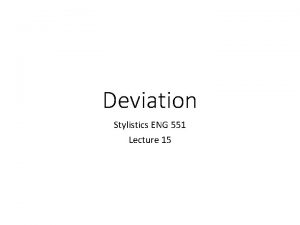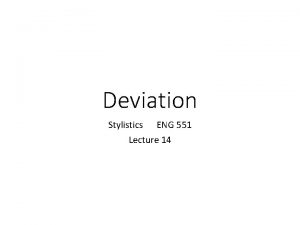Foregrounding ENG 551 Stylistics Lecture 11 Foregrounding Foregrounding











- Slides: 11

Foregrounding ENG 551 Stylistics Lecture 11

Foregrounding • Foregrounding has its origin with Czech theorist Jean Mukarovsky. • The term foregrounding is borrowed by stylisticians form art criticism, which distinguishes between the foreground and the background of a painting. • The purpose of art is to impart the sensation of things as they are perceived, and not as they are known

Foregrounding in Art • It is a general principal of artistic communication that a work of art in some way deviates form norms which we as members of a society have learnt to expect in the medium used. • A painting does not simply reproduce the visual stimuli, what is artistically significant is how it deviates form photographic accuracy, form simply being a copy of e. g. nature. • And abstract painting is interesting according to how it deviates from mass produced regularity of pattern, form absolute symmetry.

Foregrounding in Art

Foregrounding • Refers to the range of stylistic effects that occur in literature Phonetic level: alliteration, rhyme Grammatical level: inversion, ellipsis Semantic level: metaphor, irony

Foregrounding • allows literature to present meaning with intricacy which ordinary language does not allow. • immediate effect is to make objects strange and to achieve defamiliarization. Foregrounding may occur in everyday language, e. g. spoken discourse, journalistic prose but at random, with no systematic design. In literary texts foregrounding is structured, systematic and hierarchial. e. g. patterns of assonance, related group of metaphors, imagery form a particular domain etc.

Foregrounding • Foregrounding theory is related to such qualities as surprise and importance; refreshing and changing readers’ mental representation. It also describes which defamiliarization strategies these readers make use of and what the role of feeling is in this process. • Foregrounding provides readers with striking passages and experiences of defamiliarization, which arouses feelings and the readers work towards retrieving experience.

Foregrounding • The act of communication becomes secondary. Primary focus of the reader is on style. • In poetic language foregrounding achieves maximum intensity to the extent of pushing communication to the background as the object of expression used for its own sake. • Geoffery Leech places deviation in a wider aesthetic context by connecting it with general principle of foregrounding. Geoffery Leech “A Linguistic Guide to English Poetry”

Foregrounding • As a general rule, anyone who wishes to investigate the significance and value of a work art must concentrate on the element of interest and surprise. • The application of this concept to poetry is obvious. The foregrounded figure is the linguistic deviation and the background is the language.

Foregrounding • “The purpose of art is to impart the sensation of things as they are perceived and not as they are known. The technique of art is to make object unfamiliar, to make forms difficult, to increase the difficulty and length of perception because the process of perception is an aesthetic end in itself and must be prolonged” (Victor Shklovlsky) • The function of art is to renew our awareness of things that have become habitual objects of everyday awareness. For him the devices used by writhers are not merely there for ornamental purpose they serve specific functions.

Foregrounding • Foregrounding Defamiliarization Automatization Deviation Parallelism Tropes Schemes







